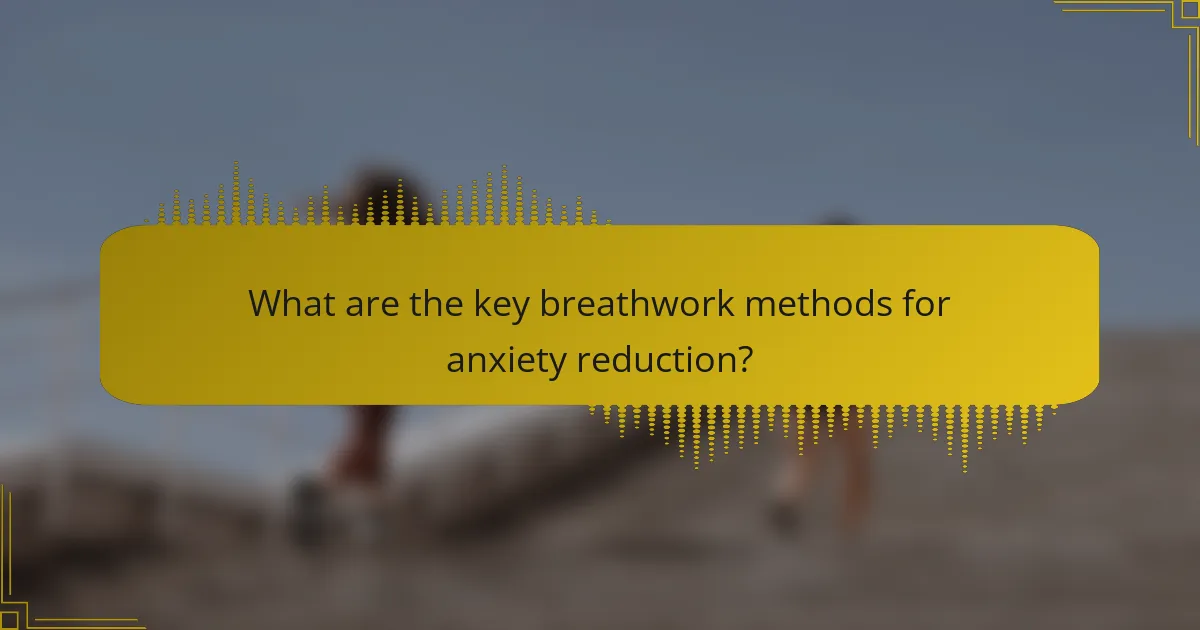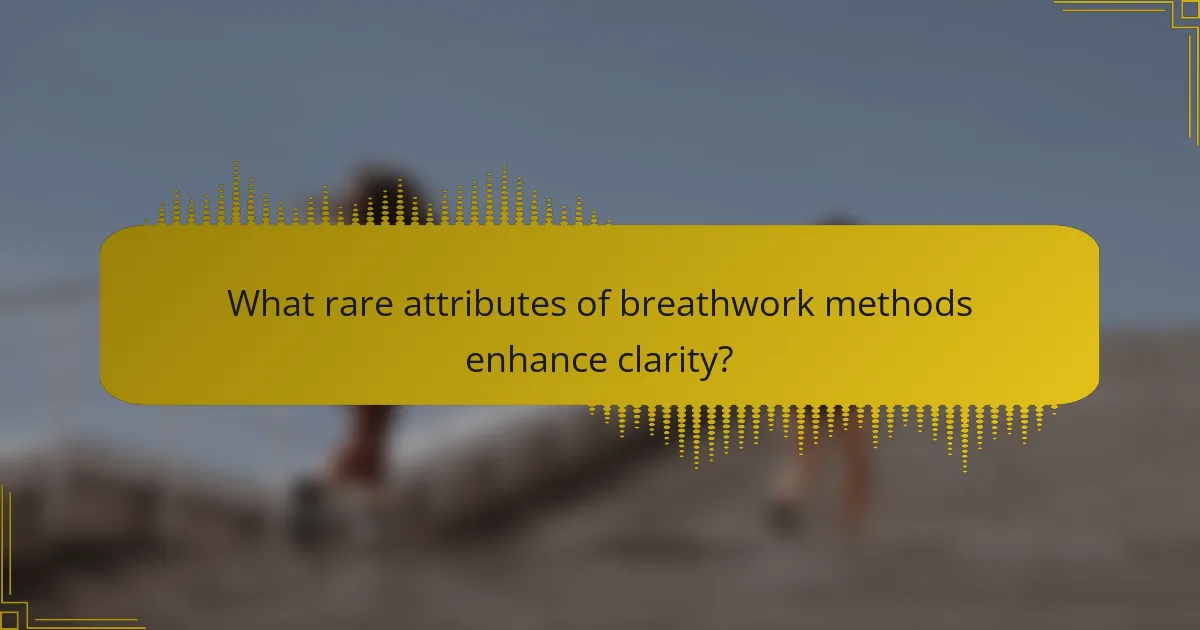Breathwork methods offer effective solutions for anxiety reduction, energy boosting, and mental clarity. Techniques like diaphragmatic breathing and box breathing enhance relaxation and stabilize emotions. Methods such as the Wim Hof Method increase alertness and vitality. Diverse cultural practices enrich breathwork, providing unique approaches to emotional healing and mindfulness. Integrating these techniques into daily routines fosters overall well-being.

What are the key breathwork methods for anxiety reduction?
Breathwork methods for anxiety reduction include techniques like diaphragmatic breathing, box breathing, and alternate nostril breathing. These methods enhance relaxation and promote mental clarity.
Diaphragmatic breathing involves deep inhalations through the nose, filling the abdomen, followed by slow exhalations. This technique decreases stress hormones and activates the parasympathetic nervous system, leading to a calming effect.
Box breathing is a structured method where you inhale for four counts, hold for four, exhale for four, and hold again for four. This rhythmic practice stabilizes emotions and enhances focus.
Alternate nostril breathing balances the body’s energy and calms the mind. Inhale through one nostril, close it, and exhale through the other. This technique fosters mental clarity and emotional stability.
Incorporating these methods into daily routines can significantly reduce anxiety levels and improve overall well-being.
How does diaphragmatic breathing help alleviate anxiety?
Diaphragmatic breathing effectively reduces anxiety by activating the body’s relaxation response. This technique lowers heart rate and cortisol levels, promoting a sense of calm. Engaging the diaphragm enhances oxygen flow, which can improve mental clarity and energy levels. Regular practice of this method can lead to long-term benefits in managing stress and anxiety symptoms.
What role does box breathing play in calming the mind?
Box breathing effectively calms the mind by regulating breath, reducing stress, and enhancing focus. This technique involves inhaling, holding, exhaling, and pausing for equal counts, typically four seconds each. As a result, it promotes relaxation and mental clarity. Studies indicate that consistent practice can lower anxiety levels and improve emotional resilience. Box breathing serves as a unique tool within breathwork methods, making it particularly beneficial for managing anxiety and boosting energy.
What are the steps to practice box breathing effectively?
To practice box breathing effectively, follow these steps:
1. Sit comfortably with your back straight.
2. Inhale deeply through your nose for a count of four.
3. Hold your breath for a count of four.
4. Exhale slowly through your mouth for a count of four.
5. Hold your breath again for a count of four.
6. Repeat the cycle for several minutes.
This method enhances relaxation and focus, making it a valuable breathwork technique for anxiety reduction.
Can alternate nostril breathing reduce stress levels?
Yes, alternate nostril breathing can reduce stress levels. This breathwork method promotes relaxation by balancing the body’s energy and calming the nervous system. Studies indicate that this technique lowers cortisol levels, a primary stress hormone, leading to decreased anxiety and improved emotional well-being. Practicing this method regularly can enhance mental clarity and boost energy, making it a valuable tool for managing stress effectively.
What is the technique for alternate nostril breathing?
The technique for alternate nostril breathing involves inhaling through one nostril, holding the breath, and exhaling through the other. This practice balances energy and promotes clarity. To perform it, follow these steps:
1. Sit comfortably with a straight spine.
2. Use your right thumb to close your right nostril.
3. Inhale deeply through your left nostril.
4. Close your left nostril with your right ring finger, then release your right nostril.
5. Exhale through your right nostril.
6. Inhale through your right nostril, close it, and exhale through your left nostril.
Repeat this cycle for several minutes to enhance focus and reduce anxiety.
How does 4-7-8 breathing support relaxation?
4-7-8 breathing promotes relaxation by regulating breath patterns and activating the parasympathetic nervous system. This method involves inhaling for four seconds, holding for seven seconds, and exhaling for eight seconds. As a result, it reduces stress hormones and enhances emotional well-being. Studies indicate that consistent practice can significantly lower anxiety levels and improve sleep quality. This technique uniquely combines breath control with mindfulness, making it effective for immediate stress relief.
What are the benefits of the 4-7-8 technique?
The 4-7-8 technique offers several benefits for anxiety reduction, energy boosting, and mental clarity. This breathwork method promotes relaxation, decreases stress levels, and enhances focus. Practicing this technique can lower heart rate, improve sleep quality, and foster emotional stability. Additionally, it may increase oxygen flow to the brain, leading to heightened clarity and cognitive function. Regular use can create a calming routine that supports overall mental well-being.

What unique attributes do breathwork methods have for energy boosting?
Breathwork methods uniquely enhance energy levels through techniques that optimize oxygen intake and promote circulation. These methods often involve rhythmic breathing patterns, activating the sympathetic nervous system, which can lead to increased alertness and vitality. Specific techniques, such as the Wim Hof Method, emphasize deep inhalation and controlled exhalation, resulting in heightened energy and mental clarity. Additionally, breathwork can stimulate the release of endorphins, contributing to an overall sense of well-being and motivation.
How does breath of fire energize the body?
Breath of fire energizes the body by increasing oxygen intake and stimulating the nervous system. This technique enhances circulation, boosts metabolism, and promotes mental clarity. As a result, practitioners often experience heightened energy levels and reduced anxiety. Regular practice can lead to improved respiratory efficiency, a unique attribute that distinguishes it from other breathwork methods.
What are the steps to perform breath of fire?
To perform the Breath of Fire, follow these steps:
1. Sit comfortably with a straight spine.
2. Inhale deeply through your nose, filling your lungs.
3. Exhale forcefully through your nose while contracting your abdominal muscles.
4. Continue this rhythmic breathing, focusing on the exhale.
5. Maintain a steady pace, ideally around two breaths per second.
6. Practice for 1-3 minutes, gradually increasing as you become more comfortable.
This technique enhances energy and mental clarity while reducing anxiety.
What is the impact of energizing breath patterns on physical performance?
Energizing breath patterns significantly enhance physical performance by increasing oxygen intake and improving focus. These techniques stimulate the autonomic nervous system, promoting alertness and vitality. Research indicates that specific breathwork methods can elevate endurance and reduce fatigue during exercise. For instance, diaphragmatic breathing has been shown to optimize lung capacity, enabling athletes to perform at higher intensities for longer durations.

What rare attributes of breathwork methods enhance clarity?
Breathwork methods enhance clarity through unique attributes like specific breathing patterns and intentional focus techniques. These methods often incorporate rare practices such as breath retention and synchronized movements, which optimize oxygen flow and stimulate mental focus. As a result, practitioners experience heightened awareness and cognitive clarity. Techniques like holotropic breathwork and pranayama uniquely contribute to this clarity by integrating emotional release and mindfulness, fostering a deeper connection to the present moment.
Can specific breath patterns improve cognitive function?
Yes, specific breath patterns can enhance cognitive function. Techniques like diaphragmatic breathing and box breathing have shown to improve focus and mental clarity. Research indicates that these methods increase oxygen flow to the brain, resulting in better cognitive performance. For instance, controlled breathing can reduce anxiety, which often hampers concentration. Regular practice may lead to long-term cognitive benefits, including improved memory and decision-making skills.
How does conscious breathwork facilitate mental clarity?
Conscious breathwork enhances mental clarity by promoting relaxation and focus. It reduces stress hormones, allowing for clearer thinking. Techniques like diaphragmatic breathing increase oxygen flow, which energizes the brain. As a result, practitioners often experience improved cognitive function and decision-making abilities. Regular practice can lead to lasting benefits in mental clarity.

What regional variations exist in breathwork practices?
Breathwork practices vary significantly across regions, influenced by cultural traditions and local needs. In Asia, techniques like Pranayama focus on breath control to enhance energy and clarity. In the Americas, shamanic breathwork integrates spiritual elements, aiming for emotional healing and anxiety reduction. European practices often emphasize therapeutic applications, utilizing breath to improve mental health. Each region’s unique approach highlights diverse attributes of breathwork, catering to specific community preferences and wellness goals.
How do cultural perceptions of breathwork influence its practice?
Cultural perceptions of breathwork significantly shape its practice, influencing techniques and acceptance. In some cultures, breathwork is viewed as a spiritual practice, enhancing its popularity for emotional healing. In contrast, other societies may prioritize its physiological benefits, focusing on anxiety reduction and energy boosting. This duality affects how practitioners approach breathwork, either as a holistic ritual or a therapeutic tool. For instance, in Eastern traditions, breathwork is often integrated with meditation, while Western approaches may emphasize structured techniques for clarity and focus. Such cultural contexts create unique attributes that enrich the overall experience and effectiveness of breathwork methods.
What localized breathwork techniques are popular in different regions?
Localized breathwork techniques vary significantly across regions, each offering unique approaches to anxiety reduction, energy boosting, and clarity.
In India, Pranayama focuses on breath control to enhance mental clarity and reduce stress. In the United States, Holotropic Breathwork combines accelerated breathing with music to facilitate emotional release and healing. The Wim Hof Method, popular in Europe, uses specific breathing patterns to boost energy and immune response. In South America, Shamanic Breathwork integrates traditional practices with breath to connect with spiritual realms. Each technique reflects cultural values and aims to address specific needs related to mental and emotional well-being.

What are the best practices for integrating breathwork into daily life?
Integrating breathwork into daily life involves consistent practice and mindful application. Start with short sessions, aiming for 5-10 minutes daily, focusing on specific techniques like diaphragmatic breathing for anxiety reduction or energizing breath patterns for an energy boost.
Establish a routine by incorporating breathwork into existing habits, such as morning rituals or breaks during work. Utilize reminders or apps to maintain consistency. Experiment with different methods to find what resonates, such as box breathing for clarity or alternate nostril breathing for balance.
As a result, regular practice enhances emotional regulation, increases energy levels, and improves mental clarity. Over time, this integration fosters a deeper connection to breath, promoting overall well-being.
How can beginners start incorporating breathwork into their routines?
Begin incorporating breathwork by starting with simple techniques. Focus on practices like diaphragmatic breathing, box breathing, or 4-7-8 breathing. These methods help reduce anxiety, boost energy, and enhance mental clarity. Set aside 5-10 minutes daily to practice, gradually increasing duration as comfort grows. Consider joining guided sessions or using apps for structured routines.
What common mistakes should be avoided when practicing breathwork?
To avoid common mistakes in breathwork, focus on proper technique, awareness of your body, and setting clear intentions. Neglecting these aspects can lead to ineffective practice or discomfort.
1. Skipping warm-up exercises can cause tension and limit benefits.
2. Overbreathing may lead to dizziness or anxiety instead of relief.
3. Ignoring personal limits can result in physical discomfort or emotional overwhelm.
4. Practicing without a clear intention may dilute the effectiveness of the session.
5. Failing to create a comfortable environment can distract from the experience.
What expert insights can enhance breathwork effectiveness?
Expert insights can significantly enhance breathwork effectiveness by incorporating specific techniques and principles. Focus on intentionality, as setting a clear purpose for each session can amplify outcomes such as anxiety reduction and energy boosting. Utilizing various breath patterns, like diaphragmatic breathing, can optimize oxygen intake and promote relaxation.
Additionally, integrating mindfulness practices during breathwork can deepen the experience, fostering clarity and emotional release. Research indicates that consistent practice can lead to long-term benefits, including improved mental health and increased resilience. Tailoring sessions to individual needs and tracking progress can further enhance effectiveness.